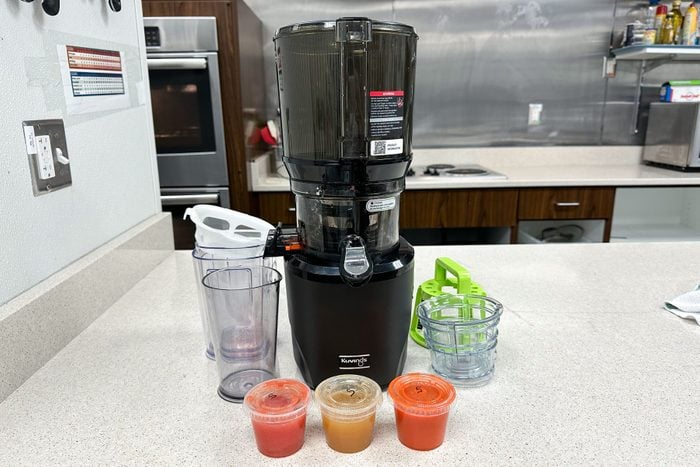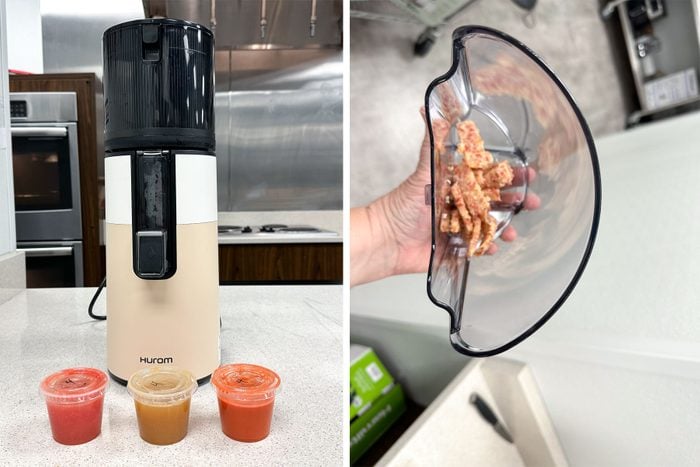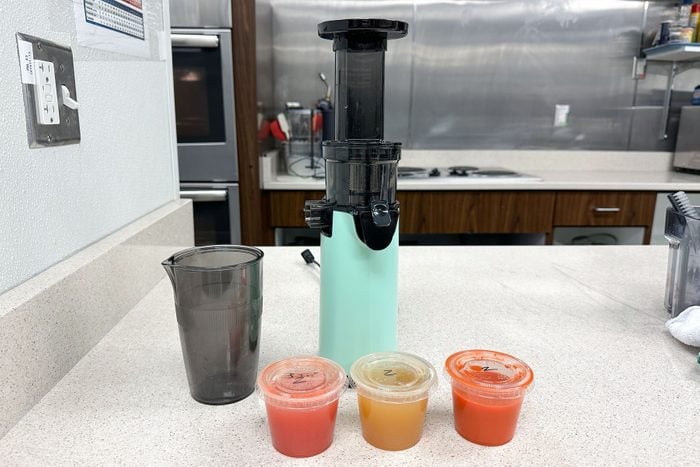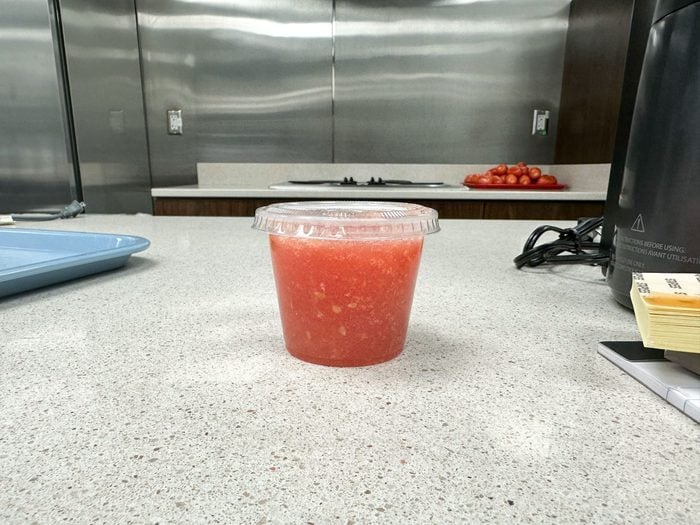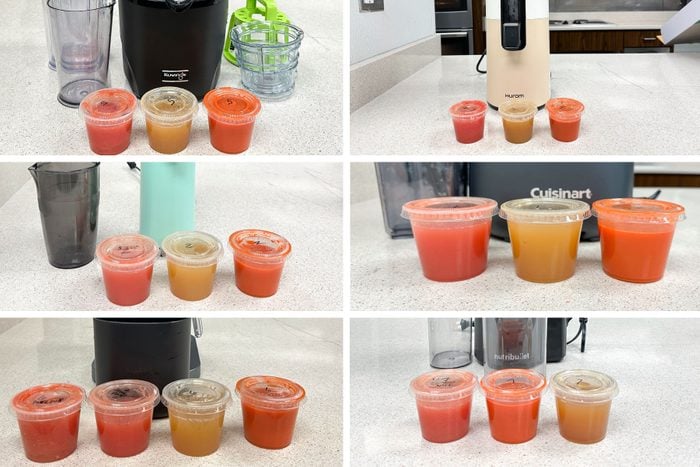TASTE OF HOME
TASTE OF HOME
Pros:
-
Quick and efficient operation
-
Larger feed chute means less prep work
-
Dishwasher-safe parts
-
Affordable option
-
Compact design
-
1-year warranty
Cons:
-
Did not extract as much juice from apples
-
Machine tended to vibrate while operating
For a mid-priced model, the Nutribullet Slow Juicer is about as speedy as they come. This high-torque, low-speed motor features a three-inch feed chute that is large enough to feed a Roma tomato without cutting.
The Nutribullet boasts a durable, steel-tipped auger that claims to wring every drop from your favorite fruits and veggies. When we put it to the test, we found it quickly and effectively extracted juice from both the tomatoes and carrots. However, when it came to the apples, it left behind some unprocessed bits in the bowl and on the screen.
The Nutribullet’s parts are dishwasher-safe, so it’s just as quick to clean as it is to operate. And thanks to its compact frame, it fits comfortably on a counter top or inside your cabinet. Nutribullet’s sister brand, Magic Bullet, also makes a mighty mini juicer that we love.
How We Tested Masticating Juicers
Taste of Home
To find the best masticating juicers, I used a combination of diligent research and hands-on testing to find the best option for every kitchen. I scoured the internet for the best slow juicers available, reading dozens of user reviews to get an idea of each product’s strengths and weaknesses.
I put eight juicers to the test over the course of a week, taking the following factors into consideration:
- Chute Size: Was the feeding chute large enough to place whole fruits and veggies, or does it require prep work?
- Self-Feeding vs. Manual: Did the machine require someone to manually feed it, or can you simply fill the hopper with produce and walk away?
- Juice Yield: Was the maximum amount of juice extracted? (This was also determined by looking at the dryness of the extracted pulp.)
- Juice Quality: Did the machine produce fresh, sweet and vibrant juice that is free of pulp?
- Pulp Control: Did the machine come equipped with pulp control settings or interchangeable pulp filters to allow for customization of juice?
Additionally, I paid special attention to footprint, noise level, appearance, ease of cleaning and whether the machine’s performance measured up to the price point.
To assess these criteria, we juiced the following produce to create a series of three identical juices:
- Large Roma tomatoes, with peel and seeds intact
- Large honey crisp apples, with core and stem removed (all juicers instruct doing so)
- Medium carrots, with tips trimmed off
After each juice test was performed, we measured the following: how long the juicing process took; whether any produce remained unprocessed; the quality of the juice (smooth and free of pulp), the actual pulp itself (the dryer the better), the temperature of the juice (temperature should remain under 70 degrees Fahrenheit to preserve nutrients), and of course, the taste of the juice.
Upon testing, only six models earned the Test Kitchen-Preferred stamp of approval, and each contender was then sorted into categories based on performance, budget and the juicing fan they’re best suited for.
Meet the Tester
TASTE OF HOME
As prep kitchen manager, I lead the prep kitchen team to ensure all food is ready for our recipe testers and associate culinary producers, as well as for our food stylists prior to being shot in our photo and video studios.
As a lifelong foodie, I bring recipes to life and contribute my expertise to articles about cooking and baking techniques and kitchen tools. I have worked in the hospitality industry for most of my career, catering and teaching cooking classes.
A masticating juicer can lend itself to endless possibilities in the kitchen that go beyond fresh pressed juice. Juiced carrots can be utilized for a delicious carrot ginger soup, and tomatoes can be juiced for a homemade sauce on pasta night. Having a quality juicer is important for whipping up both nutritious and delicious recipes, and I was thrilled to lead the testing efforts in identifying the best masticating juicers on the market today.
What to Look for When Buying a Masticating Juicer
There are many masticating juicers out there today, so you’ll want to look at a few key features to determine which option is best for your needs. In particular, the following factors set different models apart:
Type of Masticating Juicer
Masticating juicers can be horizontal or vertical, and each type has a few benefits. Vertical juicers (usually twin augers, AKA triturating juicers) have a smaller footprint, and they’re generally self-feeding, saving you from having to push produce into the augers (the parts that “chew” up the fruits/veggies). On the other hand, horizontal juicers (usually single augers) are more efficient at juicing leafy greens like kale, and some can also make nut butter and baby food.
Motor Power and Speed
- Wattage: Typically, the motors in a masticating juicer range from 150 to 400 watts. The higher the wattage, the more powerful the motor. That power also translates to what kinds of ingredients you can feed into your juicer, with higher-wattage options that can handle denser ingredients.
- Speed (RPMs): Expect to see juicing speeds between 40 and 100 RPM. The higher the RPM, the faster the juice is made. That being said, faster doesn’t necessarily mean better, especially with masticating juicers (which are intended to produce juice with pulp and flesh in it). A slower speed can mean a more thoroughly nutrient-extracted juice.
Yield and Pulp Extraction
- Adjustable Pulp Settings: If you’re not a fan of pulp, pick a juicer that allows you to adjust the pulp in your juices. Then again, if you really hate pulp, a masticating juicer might not be for you.
Ease of Use and Cleaning
- Assembly and Disassembly: Putting together and taking apart a juicer might seem like a one-time thing, but it’s not. You’ll likely be taking it apart and putting it together on some level each time you use it (at the very least, you should be taking apart the bits that require cleaning between uses). So, ensuring this process is simple and not frustrating is important to getting value out of your device (you’re likely to avoid using it if it’s too difficult).
- Cleaning: You’ll want to clean your juicer between every use—yes, really. Fruit and vegetable waste can be a source of a lot of bacteria if you don’t clean it properly, so every time you use your juicer, you’ll want to clean it. The easier your juicer is to clean, the safer it will be overall. Devices that are more difficult to disassemble and clean will likely have more nooks and crannies where bacteria can hide and thrive. Some juicers also have dishwasher-safe parts, making cleaning even easier.
Durability and Materials
- Build Quality: Higher-quality materials—especially heavy-duty metals like stainless steel—will last much longer and withstand more punishment than cheaper alternatives (like plastics). They may be more of an initial investment, but cheaper materials could break quickly and/or require more frequent replacement.
- Warranty: To get the most value from your masticating juicer, look for warranties that last at least five to ten years. This will help maintain its overall value and ensure you can get help if something goes wrong and needs fixing. Furthermore, you’ll want to consider whether you need to register your device to access the warranty.
Versatility
- Functionality: Typically, masticating juicers are a single-function device (unlike blenders, which can also be used to make soups, sauces, etc.). That being said, you’ll want to check what kinds of fruits and veggies your juicer can handle, as some are more heavy-duty than others. Hardcore juicers will cost more, but you can often get more out of them, so you’ll want to weigh that value when shopping.
Noise Level
- Quiet Operation: Ultimately, juicers are machines that make noise. And while they may not be as loud as a blender, they can get quite loud. We’ve tried to note models that make more noise than others in our guide above, but it’s important to note that they will all make some measure of noise during operation.
Size and Design
- Footprint: This applies to a juicer’s horizontal and vertical spaces. These devices are slender but tall, requiring more vertical space than horizontal. Make sure you have room on your counters for such a device before buying, or you’ll have to move it back and forth between uses, which could get frustrating quickly.
- Aesthetics: While not necessarily a make-or-break factor, you should probably make sure you like the appearance of your juicer of choice, as you’ll likely be seeing a lot of it (it is easier to keep them out on the counter than move them back and forth from storage).
Why You Should Trust Us
Catherine Ward has over 20 years of professional experience in restaurants, catering and teaching cooking classes, including six as Taste of Home‘s prep kitchen manager. She also specializes in product reviews, especially kitchen appliances, making her an authority on the subject—including masticating juicers.
Sean Tirman, Content Updates Editor at Family Handyman, updated and contributed research to this piece. Sean has written shopping guides since 2016 and is a former associate editor at Gear Patrol.
How We Found the Best Masticating Juicers
At Taste of Home, we’re serious about good food. That’s why every single recipe that our readers submit gets reviewed, made and sampled by our team of culinary experts. We want to make sure that everything from our kitchens deserves the label Test Kitchen-Approved. The same goes for products, including masticating juicers. We put each of these masticating juicers through a thorough testing process, paying close attention to their effectiveness, overall quality, durability/long-lastingness, maintenance and much more. We also considered brand reputation, professional and customer testimony, overall popularity, etc. Then, our Test Kitchen team chose the winners. Only the best-tasting and top-performing products get our stamp of approval.
FAQ
What is the best brand of masticating juicers?
All the brands in our above guide had enough to offer to garner inclusion, even after extensive testing and research—meaning they’re all worthy of consideration. That being said, Kuvings took home our best overall rating.
Are masticating juicers better?
Compared to other styles of juicers, masticating juicers could be considered better overall for nutrients and waste reduction, as they make greater use of all a fruit’s or vegetable’s constituent parts.
Which juicer extracts the most nutrients?
Compared to all other juicer styles, masticating juicers—like the ones in our guide above—extract the most nutrients, as they utilize not just the juice from the fruit but also the pulp, the flesh and even sometimes the skin/rind.
Is a masticating juicer better than a centrifugal juicer?
Masticating juicers are more efficient than centrifugal juicers, extracting more juice and nutrients from fruits and veggies. Because of this, they take a bit longer to juice, but the process results in a higher-quality juice. Plus, they’re quieter than centrifugal juicers.
How long does juice last from a masticating juicer?
About two days. Juice lasts slightly longer when using a masticating juicer versus a centrifugal juicer. A good rule of thumb is juice from masticating juicers lasts up to two days versus one day for juice from centrifugal juicers.
How do you clean a masticating juicer?
Start by turning off and unplugging the juicer. Then, disassemble the parts and remove the pulp. Individually rinse the parts and wash with a sponge in warm, soapy water, removing leftover fruit or veggie remains. Be careful not to dunk electrical components (aka the motor/base of the machine) in water. Wipe down the motor base with a cloth and reassemble when the parts are dry.








